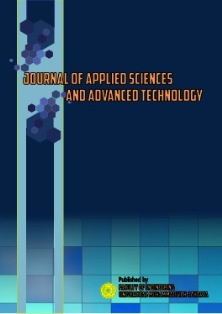Analysis of Heat Transfer of Fiber Mesocarp of Palm Oil (Elaeis Guineensis Jacq) as Roof Building
DOI:
https://doi.org/10.24853/jasat.1.1.1-8Keywords:
fiber, heat transfer, conduction, roofAbstract
Palm oil fibers are waste products from Palm Oil Mill which is in the form of debris, solid, length of 3-4 cm, contained in coconut fruit (mesocarp) meat. Fiber roof building is the result of utilization of palm fiber waste as a roof of a building that is used to reduce heat from sunlight or from heat sources, so it is not directly exposed to humans and the surrounding environment. Fiber roof building is made by arranging the fiber in the mold and arranged in accordance with the dimensions to be made. To bind between fibers, used resin that has been mixed with the catalyst material, so easy to dry quickly. The ratio between resin and fiber is 1: ¼. The result of conduction heat conduction test that has been done on the fiber test object can reduce the highest heat of 125 °C and the lowest is 109 °C from the given heat source of 200 °C. This shows that palm fiber can be used as a heat reducer for buildings.Downloads
References
Amin, Muh; Samsudi R, 2010, Pemanfaatan Limbah Serat Sabut Kelapa Sebagai Bahan Pembuat Helm Pengendara Kendaraan Roda Dua, Program Studi teknik Mesin, Fakultas Teknik Universitas Muhammadiyah Semarang, Prosiding Seminar Nasional UNIMUS.
Elisabeth, Jenny; Simon P. Ginting, 2003, Pemanfaatan Hasil Samping Industri Kelapa Sawit Sebagai Bahan Pakan Ternak Sapi Potong
Lokakarya Sistem Integrasi Kelapa Sawit-Sapi.
Handoyo, Ekadewi Anggraini, 2000, Pengaruh Tebal Isolasi Termal Terhadap EfektivitasPlate HeatExchanger, Fakultas Teknologi Industri Jurusan Teknik Mesin, Jurnal Teknik Mesin Vol. 2, No. 2, Oktober 2000: 73 – 78 Universitas Kristen Petra.
Holman, J.P. 1994. Perpindahan Kalor, Edisi Keenam, Alih Bahasa E.Jasjfi, Penerbit Erlangga, Jakarta.
Kreith, Frank; 1997, Prinsip-Prinsip Perpindahanan Panas, Edisi Ketiga, Alih bahasa Arko Prijono, Penerbit Erlangga, Jakarta.
Naibaho, Ponten. 1998. Teknologi Pengolahan Kelapa Sawit. Medan : Pusat Penelitian Kelapa Sawit.
Prasetyaningrum, Aji; 2010, Rancang Bangun Oven Drying Vaccum Dan Aplikasinya Sebagai Alat Pengering Pada Suhu Rendah, Riptek, Vol.4,No.1, Hal:45-53, Undip, Semarang.
Sardjito. 1989. Konduktivitas Termal Komposit. Bogor. Institut Teknologi Bandung.
Susanto, Eka Pradana; Biemo W Soemardi, Ivindra Pane, 2010, Studi Penggunaan Dinding Foam Concrete (Fc) Dalam Efisiensi Energi Dan Biaya Untuk Pendinginan Udara (Air Conditioner) Program Studi Teknik Sipil, Manajemen Rekayasa Konstruksi, ITB, Bandung.
Wibowo, Hary; Toto Rusianto, dan Manarul Ikhsan; Desember 2008, Pengaruh Kepadatan dan Ketebalan Terhadap Sifat Isolator Panas Papan Partikel Sekam Padi, Jurusan Teknik Mesin Fakultas Teknologi Industri Institut Sains & Teknologi AKPRIND Yogyakarta, Jurnaltek, Volume 1 No.2, hal 107-111.
Rahardja, Istianto budhi, 2011, Pendayagunaan Serat Kelapa Sawit sebagai Bahan Isolator Panas, Jurnal Teknosain, Vol.VIII, No. 3, Oktober 2011.
Downloads
Published
Issue
Section
License
COPYRIGHT POLICY
The author(s) of an article published in the Journal of Applied Sciences and Advanced Technology (JASAT) retains ownership of the intellectual property rights in work (s).
PUBLISHING RIGHTS
The author(s) of an article published in the Journal of Applied Sciences and Advanced Technology (JASAT) have unrestricted publication rights. The authors give the Journal of Applied Sciences and Advanced Technology (JASAT) the right to publish the article and designate the Faculty of Engineering Universitas Muhammadiyah Jakarta Publishing as the original publisher of the article.
LICENSING POLICY
JASAT is an open-access journal that follows the Creative Commons Non-Commercial 4.0 International License (CC BY-NC 4.0), which states that:

Under this license, the reusers must give appropriate credit, provide a link to the license, and indicate if changes were made. Users may do so in any reasonable manner, but not in any way that suggests the licensor endorses users or their use.
Please take the time to read the whole license agreement (https://creativecommons.org/licenses/by-nc/4.0/). As long as reusers follow the license conditions, the owner cannot withdraw these freedoms. The following components are included under this license:
 Attribution: Users must provide appropriate attribution, including a link to the license, and indicate whether or not they made any modifications. Users are free to do so reasonably, but not in a manner that indicates the licensee approves of their usage.
Attribution: Users must provide appropriate attribution, including a link to the license, and indicate whether or not they made any modifications. Users are free to do so reasonably, but not in a manner that indicates the licensee approves of their usage.
 NonCommercial: Users may not use the material for commercial purposes.
NonCommercial: Users may not use the material for commercial purposes.












_2.png)


1.png)

2.png)
